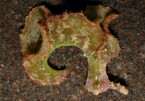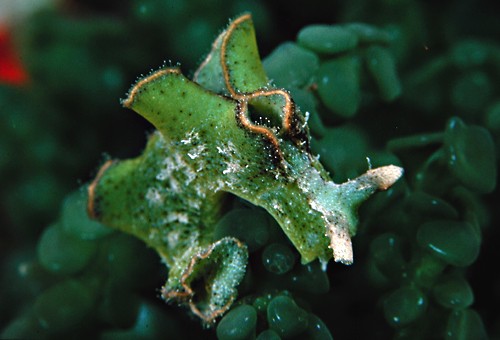| Home |
| Acknowledgments |
| Conventions |
| Glossary |
| Maps |
| References |
| Links |
| Articles |
| Thumbnails |
| Species
list |
| Family |
| Next
species |
Additional Photos

underside

young, about 4 mm

migratory form

sedentary form
parapodia
papillae
sparse papillae

violet patches

dark rhinophores

feeding

egg mass
_______________
GALLERY

Elysia tomentosa Jensen, 1997

| Maximum size: 40 mm. Identification: This is a highly variable species with sedentary and migratory forms as well as various intergrades. The sedentary form has tall, thin, lightly-papillate parapodia containing elaborate ramifications of the digestive gland. The parapodia are usually held in three chimneys and are bright to dull green with white flecks and small, solid-brown dots. There is a pale orange marginal line and, sometimes, a faint brown sub-marginal line. The migratory form is usually smaller (seldom exceeding 24 mm) with lower parapodia and better developed papillae. Its dark spots may be ocellate rather than solid and it is usually light olive in color. The papillae may vary from fine and branching with branches of the digestive gland in their centers to broad and conical without branches of the digestive gland in their centers. (Note 1) In some animals, there may be a violet-black band (sometimes interrupted) surrounding the posterior extension of the pericardium. (Note 2) Background color is probably derived primarily from retained chloroplasts and usually matches the color of the animal's food algae. Occasional animals may have dark pigment on their rhinophores. Natural history: The sedentary form of Elysia tomentosa is commonly found in stands of large-form Caulerpa racemosa. (Note 3) Such stands usually occur in protected to exposed locations at depths of < 1 m (< 3 ft) but are seldom extensive. The migratory form is moderately common and is found on shallow rocky bottoms at depths of 1-2 m (3-6 ft) where it apparently feeds primarily on small, widely scattered clumps of Caulerpa serrulata. Mature animals are diurnally active and may jerk their parapodia occasionally while crawling. They typically rest in the open at night with the parapodia spread. (Note 4) We've observed feeding on C. racemosa (both large and small forms) and C. serrulata in dishes. However, individuals may accept or reject pieces of apparently identical algal clumps. (Note 5) Keoki Stender also reports finding it on Caulerpa taxifolia. (Sea Slug Forum) The egg mass is a flattened, 3/4 mm to 1 mm wide, yellow ribbon composed of a smaller egg string laid down in a zig-zag pattern. It is deposited in a loosely coiled, irregular spiral. An irregular band of bright yellow extra-capsular yolk runs along the upper surface of the string emphasizing the zig-zag pattern. The eggs hatch in about six days in the laboratory. The extra-capsular yolk remains in the egg mass after hatching. (Note 6) (Note 7) Distribution: Big Island, Maui, Lanai, Oahu, Kauai and Midway: widely distributed in the Indo-Pacific. Taxonomic notes: This is the species that Kay, 1979 lists as Elysia cf. cauze Marcus, 1957. It has also been listed in some sources as Elysia expansa (O'Donoghue, 1924). See the Sea Slug Forum for further discussion. There's some possibility that the Indo-Pacific population may be a complex. Photo: Mike Severns: sedentary form; about 30 mm: found by PF & CP on an exposed patch of large-form C. racemosa; outside Ko'ie'ie Fish Pond, Kalepolepo, Maui; Sept., 1990. Observations and comments: Note 1: The suggestion that animals with fine and conical papillae are the same species is supported by three animals that were raised in dishes for several weeks on a diet of Caulerpa racemosa and C. serrulata but in relatively low light. In all three cases, the papillae changed from fine and branching to short and conical during the course of the experiment. During this process, visible branches of the digestive gland in the papillae were lost.(see photos) Note 2: The violet-black line around the posterior extension of the pericardium largely disappeared in an animal held between Oct. 10 and Dec. 11 in 2002 and fed Caulerpa racemosa and C. serrulata. That suggests that its presence or absence may be related to diet or age. Note 3: Elysia tomentosa is often found in much higher densities on the large form of Caulerpa racemosa than on other hosts with little apparent damage to the algae. This suggests that it may be getting more of its nutrition from retained chloroplasts when feeding on that form and supports the suggestion that morphology and behavior may change depending on the host algae and its chloroplasts. Note 4: When several animals of the sedentary form were held in a dish with a clump of large-form C. racemosa, they spent the day tucked among its branches but left the alga at night to rest on the nearby surface. The migratory form has also been seen resting in the open at night. Perhaps, this is a response to reduced oxygen concentrations between the tightly packed algal branches? Note 5: In Oct. 2004, a captive animal had been fed pieces from a large clump of Caulerpa serrulata. Then, a second captive E. tomentosa was released on that clump. Over several days, about 1/3 to 1/2 of the clump disappeared in the field. Afterwards, the first animal was fed another sprig from the same clump. It responded by turning dark green, becoming "quiescent" and developing necrotic patches on its parapodia (with subsequent tissue loss). Afterwards, it recovered and continued to feed on pieces of C. serrulata from other clumps. This suggests that the alga may produce defensive toxins in response to grazing. Animals have also been observed accepting or rejecting pieces from otherwise identical clumps of the small form of C. racemosa. Perhaps, that species also produces toxins that vary in concentration due to either genetic or environmental factors? Note 6: An animal held in isolation from Nov. 10 till Dec. 11 in 2002 laid six consecutive egg masses. The first three were fertile but the second three were not, suggesting that sperm may be retained for at least 13 days (the third mass was laid on Nov. 23). The animal was fed Caulerpa racemosa and C. serrulata. Note 7: A 4 mm juvenile fed Caulerpa racemosa and C. serrulata reached 18 mm in 12 days. This growth rate is much faster than that observed in animals that were mature when captured suggesting an initial "spurt" followed by a decline in growth rate after sexual maturity. (see photos) Addendum: Subsequent to most of the observations detailed above, Caulerpa macrophysa was split out of the large form of C. racemosa, and Caulerpa nummularia was split out of the small form of C. racemosa (Abbott & Hohn, 2004) ( Huisman, Abbott & Smith, 2007). So, the different responses to the various forms of C. racemosa mentioned above may represent different responses to those species, instead. |
| Thumbnails |
Species
list |
Family | Next species | Top |